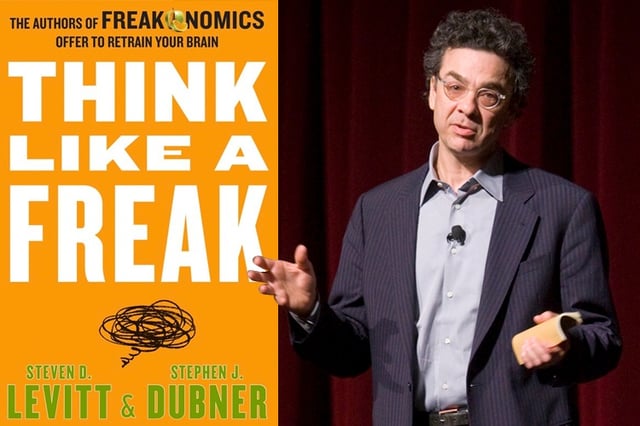Share this
The Upside to Quitting
by SelectOne on Tue, Mar 29, 2016

As the saying goes: "Winners never quit and quitters never win." Well, what if we thought of this a little differently.
As a recruiter, I encounter people on a daily basis who are open to explore new opportunities and quit their current job. There are a variety of reasons contributing to this life-changing decision including - culture, work/life balance, the next step in their career, salary, benefits, etc.
However, there are also multiple reasons that make people apprehensive or nervous to quit - such as: the fear of change, complacency, salary, and many other factors.
At ASA Staffing World 2015, I was introduced to the book, “Think Like a Freak” written by the authors Stephen J. Levitt and Stephen J. Dunbar.
One chapter in particular stuck out to me titled, “The Upside of Quitting.” This chapter covers several posed questions, experiments, and results surrounding the upside of quitting (whether it be your job, a habit, a relationship, or a project).
Through research and experimentation, Levitt and Dunbar found that a high percentage of those that quit found themselves to be happier. However, in order for someone to successfully quit they must overcome 3 biases that affect the human’s mentality to not quit.
Overcoming the 3 biases to quitting:
1) Sunk-cost fallacy
This is the belief that it is counterproductive to give up and quit after you’ve invested your time, money and brainpower into a project, so you continue to expend all your energy into that project to “avoid failure.”
In the book, an example was given of two country governments that partnered together to invest billions of dollars into a project that was not “economically viable.” Despite the ineffectiveness of the project, the two patrons continued to throw resources at it - including people’s time and brainpower – simply because they didn't like the idea of quitting.
Rather than throwing your resources away, how else could you better utilize your time, money, and brainpower?
2) Focus on concrete costs and not opportunity cost
Another force prohibiting people from quitting is the tendency to focus on concrete costs, aka the sunk-cost fallacy contributors: time, money, and brainpower, rather than the opportunity cost of surrendering your efforts to invest them elsewhere.
Unlike opportunity costs, concrete (or tangible) costs are easier to calculate.
For example:
You’re interested in going back to school for your MBA, you know it will cost at least two years of your time and $100,000 (concrete costs). However, you can't help but think - what could I do with that time and money if I weren’t in school (opportunity cost)? Might you be doing something that makes your life more fulfilling, happier, productive, and exciting?
3) Quitting is a sign of failure
We live in a society accustomed to the belief that quitting is a sign of failure and no one likes to fail.
But, looking at the big picture, is quitting and failing really so terrible?
The Stephens' don't think so - for every ten research projects they conduct they abandon nine. If they didn't walk away from those 9 ‘duds’ they would have had too much on their plates to focus on the one success.
So, are those 9 ‘dud’s a total loss?
The Stephens’ say no because failure can provide valuable feedback. It gives you the knowledge and expertise on how to approach things moving forward and what works and what doesn't work for the next time. Knowing when to walk away is a challenge, but it’s nothing more than a temporary setback.
So, to sum it up: quitting can mean winning, and winners can quit. But remember, quitting is not the enemy of success. And to be clear, this doesn't mean you should quit everything, but just think a little differently about what the cost and opportunity means to you and the consider the upside to quitting.
Share this
- October 2022 (2)
- September 2022 (1)
- August 2022 (1)
- July 2022 (4)
- June 2022 (3)
- May 2022 (2)
- February 2022 (2)
- May 2020 (2)
- April 2020 (8)
- March 2020 (6)
- February 2020 (4)
- January 2020 (2)
- December 2019 (3)
- November 2019 (2)
- October 2019 (9)
- September 2019 (6)
- May 2019 (4)
- April 2019 (9)
- March 2019 (7)
- February 2019 (10)
- January 2019 (4)
- December 2018 (12)
- November 2018 (6)
- October 2018 (4)
- September 2018 (6)
- August 2018 (14)
- July 2018 (8)
- June 2018 (7)
- April 2017 (1)
- February 2017 (5)
- January 2017 (8)
- December 2016 (8)
- November 2016 (3)
- October 2016 (7)
- September 2016 (8)
- August 2016 (7)
- July 2016 (6)
- June 2016 (9)
- May 2016 (7)
- April 2016 (9)
- March 2016 (8)
- February 2016 (6)
- January 2016 (8)
- December 2015 (7)
- November 2015 (7)
- October 2015 (7)
- September 2015 (8)
- August 2015 (11)
- July 2015 (8)
- June 2015 (4)
- May 2015 (5)
- April 2015 (4)
- March 2015 (4)
- February 2015 (7)
- January 2015 (8)
- December 2014 (5)
- November 2014 (2)



No Comments Yet
Let us know what you think